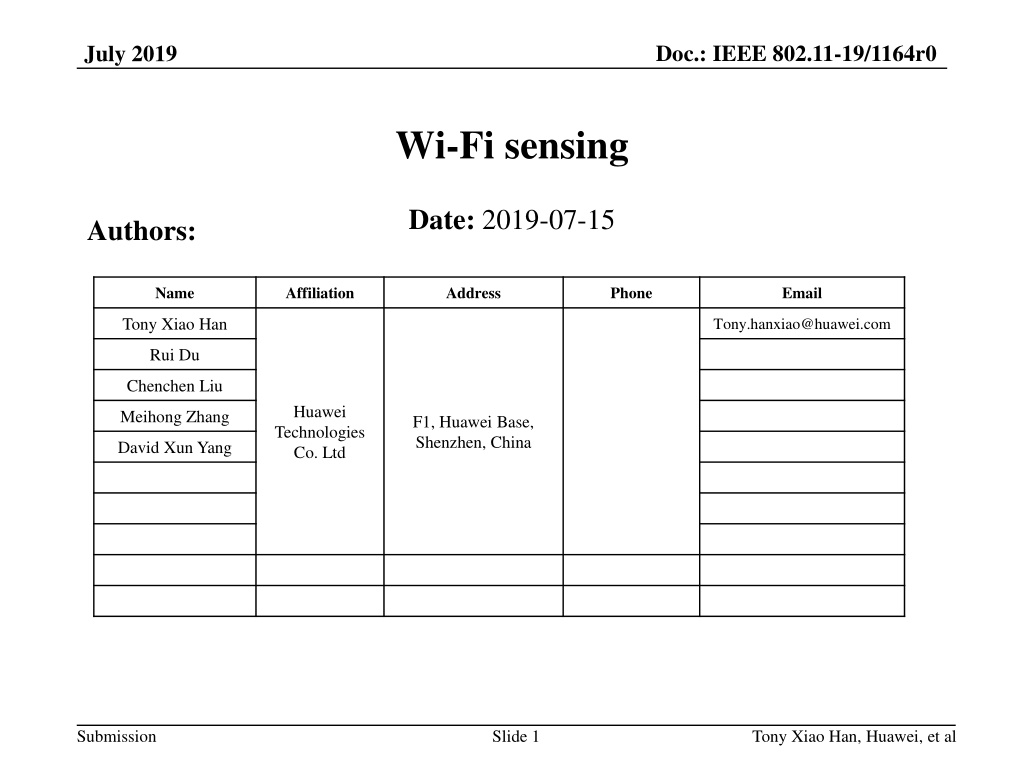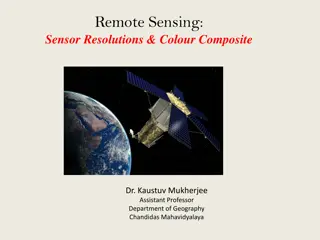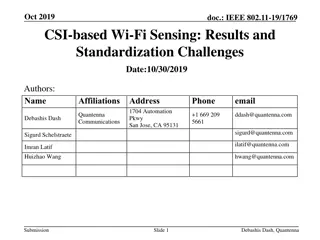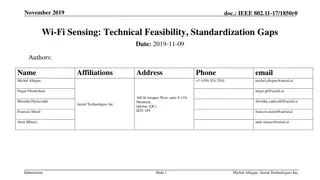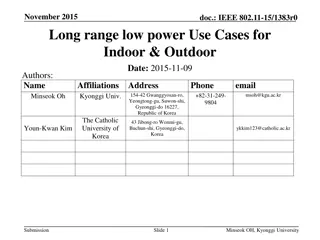Wi-Fi Sensing in IoT: Advantages, Use Cases, and Challenges
Wi-Fi sensing utilizes Wi-Fi devices/network to detect presence, range, angle, and velocity of passive/non-transceiver objects. This document discusses the definition, advantages, use cases like smart home applications, and challenges of Wi-Fi sensing compared to other sensing technologies. It also highlights the need for standardization and technological enhancements in existing IEEE 802.11 protocols for efficient Wi-Fi-based sensing implementations.
Download Presentation

Please find below an Image/Link to download the presentation.
The content on the website is provided AS IS for your information and personal use only. It may not be sold, licensed, or shared on other websites without obtaining consent from the author.If you encounter any issues during the download, it is possible that the publisher has removed the file from their server.
You are allowed to download the files provided on this website for personal or commercial use, subject to the condition that they are used lawfully. All files are the property of their respective owners.
The content on the website is provided AS IS for your information and personal use only. It may not be sold, licensed, or shared on other websites without obtaining consent from the author.
E N D
Presentation Transcript
Doc.: IEEE 802.11-19/1164r0 July 2019 Wi-Fi sensing Date: 2019-07-15 Authors: Name Affiliation Address Phone Email Tony Xiao Han Tony.hanxiao@huawei.com Rui Du Chenchen Liu Huawei Technologies Co. Ltd Meihong Zhang F1, Huawei Base, Shenzhen, China David Xun Yang Submission Slide 1 Tony Xiao Han, Huawei, et al
Doc.: IEEE 802.11-19/1164r0 July 2019 Outline 1. What is Wi-Fi sensing? 2. Why considering Wi-Fi based sensing? 3. Use cases of Wi-Fi sensing 4. Current status of Wi-Fi sensing 5. Technology and standardization gaps 6. Summary 7. References Submission Slide 2 Tony Xiao Han, Huawei, et al
Doc.: IEEE 802.11-19/1164r0 July 2019 1. What is Wi-Fi sensing? Wi-Fi sensing definition Using Wi-Fi devices/network to measure/determine the presence, range, angle, and/or velocity of passive/non transceiver objects. Key point Using Wi-Fi o Use Wi-Fi devices/network o Reuse existing Wi-Fi protocols (e.g., trigger based transmission) o Still there are technology and standardization gaps (see section 5) with respect to existing technologies in IEEE 802.11 Passive/non transceiver objects o The object, which is the target of measurement/detection, is not required to carry any hardware/transceiver device (i.e., is not required to be equipped with a cooperative device). Wi-Fi sensing is not within the scope of 802.11az 802.11az is for measuring/determining the range, angle, and/or velocity of active/transceiver devices In other word, the object, which is the target of measurement/detection, is required to carry a hardware/transceiver device (i.e., is required to be equipped with a cooperative device). Submission Slide 3 Tony Xiao Han, Huawei, et al
Doc.: IEEE 802.11-19/1164r0 July 2019 2. Why considering Wi-Fi based sensing? Comparing with other technology (e.g., acoustic) based sensing, the advantages of Wi-Fi based sensing Reuse of connectivity technology (i.e., Wi-Fi) for sensing will shorten and simplify technology development Wi-Fi is almost ubiquitous in many indoor environments (e.g., home, malls, retail chains, airport). Combining sensing with Wi-Fi could also make sensing function ubiquitous. Adding sensing as an additional function into Wi-Fi, will be beneficial for the Wi-Fi ecosystem. Challenges of Wi-Fi sensing Wi-Fi network is designed originally for data transmission, without considering about sensing function. Hence, some modifications may be needed for Wi-Fi standard. o See Section 5 (Technology and Standardization gaps) for details. Submission Slide 4 Tony Xiao Han, Huawei, et al
Doc.: IEEE 802.11-19/1164r0 July 2019 3. Use cases of Wi-Fi sensing (1/4) Smart home, Room sensing Home monitoring: monitoring daily movements and health conditions of human beings, such as walk (gait), sleep, fall, breath, heartbeats. Home security: detecting intruders approaching house/home. Energy management: based on the results of Wi-Fi sensing, optimize smart thermostat settings, automatically adjust lighting Emotional recognition: based on breath, heartbeats and/or facial analysis https://www.smart-energy.com/wp- content/uploads/2016/10/energy-management-systems.jpg https://www.nwsystemsgroup.com/wp- content/uploads/2018/07/building-exterior-radar-technology.jpg https://www.cse.ust.hk/~qianzh/research/sensing-2.jpg https://www.researchgate.net/profile/Leon_Rothkrantz2/publication/228774612/figure/fig1/AS:300794202083332@1 448726334409/The-Web-based-emotion-recognition-system-performs-analysis-on-both-audio-and-video-data.png Submission Slide 5 Tony Xiao Han, Huawei, et al
Doc.: IEEE 802.11-19/1164r0 July 2019 3. Use cases of Wi-Fi sensing (2/4) Interactive gaming/control Playing game with body movement Controlling smart devices by body movement and gesture http://4.bp.blogspot.com/-_krIAHPdn- https://www.pressebox.com/pressrelease/gb-pronova-gmbh/HoloPro-and-the-magic-of- interactive-control/boxid/129647# 8/T02hISBvOnI/AAAAAAAAA1A/jAufr2N8k4c/s1600/Kinect%2BGames.jpg https://ksassets.timeincuk.net/wp/uploads/sites/54/2015/06/soli5-2-620x349.jpg Submission Slide 6 Tony Xiao Han, Huawei, et al
Doc.: IEEE 802.11-19/1164r0 July 2019 3. Use cases of Wi-Fi sensing (3/4) Location in store The user is going around in the store, and does not need to carry a Wi-Fi device Wi-Fi sensing is used to indicate whether the user is moving, or whether the user is stopped in front of some products Wi-Fi sensing is used to determine, e.g., the number of users facing a specific product, the time duration of the user stopped in front of a specific product http://img.wezhan.cn/content/sitefiles/88646/images/12157659_%E8%B6%85%E5%B8%82%E5%AE%9A%E4%BD%8D3.jpeg Note: This use case is modified based on the usage model No.11 for 11az [1], which require the user to wear a Wi-Fi device. Submission Slide 7 Tony Xiao Han, Huawei, et al
Doc.: IEEE 802.11-19/1164r0 July 2019 3. Use cases of Wi-Fi sensing (4/4) Audio with user tracking (Follow-me sound) The user does not need to wear a Wi-Fi device. The user s position is continuously monitored. The audio system adjusts the speaker settings according to the user s position and movement for immersive sound experience. https://uppic-fd.zol-img.com.cn/g5/M00/0D/0A/ChMkJllWFZuIdf9SAAOoPtMQwRcAAdx4wF6HpAAA6hW306.jpg Note: This use case is modified based on the usage model No.2 for 11az [1], which require the user to wear a Wi-Fi device. Submission Slide 8 Tony Xiao Han, Huawei, et al
Doc.: IEEE 802.11-19/1164r0 July 2019 4. Current status of Wi-Fi sensing Now, discussion for something more and something new Radar related description was adopted by 11ay WBA: A new proposal about Wi-Fi sensing [2] Initial Radar discussion in 11ay [3-5] Standard activities 12 2018.10 2019.1 11 2 4 3 5 6 7 Industry activities Now Project Soli got FCC s approval to operate miniature radar-based sensors at higher power levels [7] Snapdragon 855 is released, with Always-on Wi-Fi sensing Current status Oct 2018, a new proposal about Wi-Fi sensing was submitted in WBA [2] Nov 2018, there was an initial radar discussion in 11ay [3-5] Dec 2018, Snapdragon 855 is released, with a feature called Always-on Wi-Fi sensing [6] Jan 2019, Radar related description was adopted by 11ay Jan 2019, Project Soli got FCC s approval to operate miniature radar-based sensors at higher power levels [7] More startups are using Wi-Fi to do sensing [8] Lots of academic research papers using commercial off-the-shelf Wi-Fi (below 7GHz) for sensing researches and applications [9] Now, we are here to discuss something more and something new Submission Slide 9 Tony Xiao Han, Huawei, et al
Doc.: IEEE 802.11-19/1164r0 July 2019 5. Technology and standardization gaps Target frequency bands could be Sub 7GHz: e.g., 802.11 n/ac/ax/be in 2.4/5/6GHz Above 7GHz: e.g., 802.11 ad/ay/ in 60GHz Technology and standardization gaps - PHY New signal/waveform design for sensing purpose Mono-static / Bi-static / multi-static based schemes (See Appendix I for definition) Other? Technology and standardization gaps - MAC Mechanism for low-overhead channel response measurement Specific sensing frame definition Sensing procedures/protocols design, could be new or existing procedures/protocols Coexistence schemes Other? Submission Slide 10 Tony Xiao Han, Huawei, et al
Doc.: IEEE 802.11-19/1164r0 July 2019 6. Summary In this presentation, the following topics are discussed Definition, Advantage, Use case, and Current status of Wi-Fi sensing Technology and standardization gaps for Wi-Fi sensing To enable richer Wi-Fi applications and the growth of Wi-Fi ecosystem, maybe now is the right time for the group to take the next step for Wi-Fi sensing, and this could be done in a dedicated Study Group. Submission Slide 11 Tony Xiao Han, Huawei, et al
Doc.: IEEE 802.11-19/1164r0 July 2019 7. References [1] 11-16-0137-04-00az-ngp-use-case-document.pptx [2] https://wballiance.com/wi-fi-sensing-new-style/ [3] 11-18-2094-00-00ay-wlan-radar.pptx [4] 11-18-2095-01-00ay-wlan-radar-annex.docx [5] 11-19-0080-00-00ay-further-discussion-for-wlan-radar.pptx [6] https://www.qualcomm.com/products/snapdragon-855-mobile-platform [7] https://techcrunch.com/2019/01/02/us-fcc-approves-google-soli-project/ [8] https://www.cognitivesystems.com/ [9] Jiang, Hongbo, Chao Cai, Xiaoqiang Ma, Yang Yang, and Jiangchuan Liu. "Smart home based on WiFi sensing: A survey." IEEE Access 6 (2018): 13317-13325. Submission Slide 12 Tony Xiao Han, Huawei, et al
Doc.: IEEE 802.11-19/1164r0 July 2019 Straw poll 1 Do you think Wi-Fi sensing would be an interesting topic for 802.11 to study? Yes: No: Abstain: Submission Slide 13 Tony Xiao Han, Huawei, et al
Doc.: IEEE 802.11-19/1164r0 July 2019 Straw poll 2 Do you support the formation of a new 802.11 Study Group to develop PAR and CSD for Wi-Fi sensing technologies? Yes: No: Abstain: Submission Slide 14 Tony Xiao Han, Huawei, et al
Doc.: IEEE 802.11-19/1164r0 July 2019 Appendix I: Different types of radar Monostatic radar is a type of radar in which the transmitter and receiver are collocated. Bistatic radar is the name given to a radar system comprising a transmitter and receiver that are separated by a distance comparable to the expected target distance. A system containing multiple spatially diverse Monostatic radar or Bistatic radar components with a shared area of coverage is called Multistatic radar. Multistatic Radar http://www.rfwireless-world.com/Terminology/Monostatic-radar-vs-Bistatic-radar.html https://en.wikipedia.org/wiki/Multistatic_radar Submission Slide 15 Tony Xiao Han, Huawei, et al
